#best codeless automation tool
Explore tagged Tumblr posts
Text
No-Code Test Automation: Reducing the Skill Barrier in Software Testing
Introduction to No-Code Test Automation
Begin with an overview of no-code test automation, explaining how it allows users to build and execute automated tests without programming skills. Emphasize that this approach removes entry barriers, making software testing accessible to more team members.
How No-Code Automation Reduces the Skill Barrier
Visual Workflows and Drag-and-Drop Interfaces: Describe how no-code platforms allow users to create tests through visual workflows, eliminating the need for complex scripting and enabling faster test setup.
Reusable Components: Explain how reusable test modules simplify test design, making it easy for users with limited technical skills to create comprehensive test suites.
Cross-Functional Collaboration: Discuss how no-code platforms empower non-technical stakeholders—such as business analysts and product managers—to participate in testing, fostering a more collaborative QA environment.
Conclusion
Summarize by highlighting that no-code test automation is transforming software testing by reducing reliance on coding, enhancing collaboration, and enabling faster and more efficient testing processes for teams of all skill levels.
#codeless test automation#no code test automation#codeless automation tools#codeless test automation tools#no code test automation tools#low code test automation#best codeless automation tool#test automation software#automated testing tools#automated qa testing
0 notes
Text
Automation Testing Insights: Transforming Testing
The global automation testing market size is expected to reach USD 92.45 billion by 2030. Prominent technological advancement in artificial intelligence (AI) and machine learning (ML) is propelling the demand for the market. Mobile application usage is growing across various end-user industries, and smartphone penetration is rising, opening an attractive potential for market expansion. Furthermore, there is a rising demand for automation testing as web-based applications have developed significantly and new software technologies have emerged. The market is growing rapidly due to the increasing usage of ML and AI for advanced analytics and continuous testing across DevOps and DevSecOps areas.
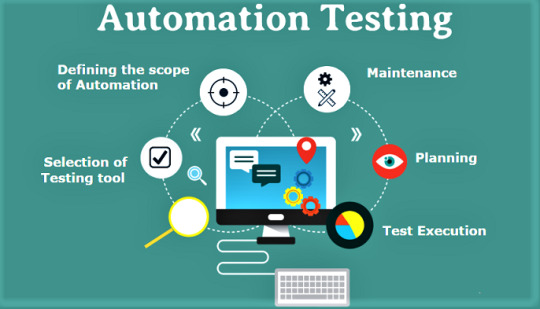
Automation Testing Market Report Highlights
The services segment dominated the market and accounted for over 56% of the global revenue owing to rapid advancements in implementation services, which make it easier to include automation into a functioning infrastructure for software testing
With the aid of this service, automation is integrated into an existing software automation testing setup
The large enterprises segment held the largest revenue share in 2022 as it helps improve efficiency, reduce manual effort, increase test coverage, and ensure the quality of software applications
The BFSI segment is estimated to have significant growth over the forecast period; adopting digitalization in the BFSI sector creates a significant demand for application software automation testing
Gain deeper insights on the market and receive your free copy with TOC now @: Automation Testing Market Report
The emerging use of RPA to automate time-consuming, error-prone manual processes are just a few instances of the usage of AI & ML in automation testing. Moreover, a bot uses the page’s numerous links and web forms to systematically explore through an online application when web crawling or spidering. This is a new use for AI and ML in automation testing. This approach is typically used for indexing online browsing. It may be improved further to perform reverse engineering on an application being tested and automatically find Test Cases. Emerging automation testing tools are significantly fueling market growth.
For instance, Testcraft, a codeless Selenium test automation platform for regression and continuous testing, as well as monitoring of web applications, is gaining traction among users. Their revolutionary AI tech removes maintenance time and cost, as it certainly affects changes in the app. Similarly, Applitools Eyes, Testim, and Test.ai are more automation testing tools propelling the market growth. Furthermore, mergers and acquisitions by other key players are propelling market growth. For instance, in 2022, to improve the user experience on 5G smartphones, Key sight introduced AI-driven and automated testing. Automation and AI enable mobile service providers and app developers to more swiftly evaluate how smartphone users engage with native apps in the real world.
#Automation Testing#Quality Assurance#Software Testing#Test Automation#Continuous Testing#Test Automation Framework#DevOps Testing#Selenium#Test Automation Tools#Performance Testing#Regression Testing#Agile Testing#UIAutomation#Test Scripting#Test Automation Engineer#Codeless Automation#Automation Strategy#CI/CDTesting#Test Automation Best Practices
0 notes
Text
Best Practices for Successful Automation Testing Implementation

Automation testing is an essential part of modern-day software development that accelerates delivery, reduces manual work, and improves software quality. But success in automation testing is not assured, it should be achieved by proper planning and execution along with proper compliance of best practices.
In this blog, we will talk about key actionable strategies and best practices to ensure the successful implementation of automation testing in your projects.
1. Start with a Clear Strategy
Jumping straight into automation testing without a clear strategy will not always yield the desired results. Define the following:
Objectives: Define the goals of the automation, whether it is about shorter test cycles, improved test coverage or eliminating human error.
Scope: Set the areas of your application for automation and focus much on areas that have a high impact like regression and functional testing.
Stakeholders: Get early involvement from the development, QA and product teams to avoid misalignment regarding expectations.
A well-formed strategy helps guide the way and make sure everyone involved is aligned.
2. Prioritize the Right Test Cases for Automation
One of automation testing’s biggest mistakes with it is to use automation for everything. Rather than that, shape your test cases to that of:
Are monotonous and time-consuming.
Wherein critical for application functionality
Have stable requirements.
Some of these tests are regression tests, smoke tests, data-driven tests, etc. Do not automate the exploratory or highly dynamic tests that often get changed.
3. Choose the Right Automation Tools
The effectiveness of your automation testing initiative highly relies on appropriate tools selection. Look for tools that:
Support the technology stack of your application (e.g., web, mobile, APIs).
Give the flexibility to expand your project.
Offer extensive reporting, reusability of scripts, and run across browsers.
GhostQA is one example of a codeless platform that works well for teams across the skill set. GhostQA can let you focus on what matters and Auto Healing reduces your maintenance to enforce.
4. Build a Strong Automation Framework
An automation framework is the backbone of your automation testing process. It helps in standardization, reusability and scalability of test scripts. So, when you start designing your framework, make sure to leave some room for these features:
Modularity: Split test scripts into reusable components
Data-Driven Testing: Use Data-Driven Testing to separate test data from the scripts to provide flexibility.
Error Handling: Install anti-malware solutions to prevent potential threats.
A good framework streamlines collaboration and makes it easier to maintain your tests.
5. Write High-Quality Test Scripts
A good test script decides the reliability of your automation testing. To ensure script quality:
When naming scripts, variables, or methods, use meaningful and descriptive names.
For adaptability, you should leverage parameterization instead of hardcoding these values.
Set up appropriate error-handling procedures for handling unforeseen problems.
Do not add anything unnecessarily, the more complexity, the more difficult it is to debug and maintain.
Tools such as GhostQA minimize the efforts put behind scripting providing no-code possibilities allowing even non-technical users to write robust tests.
6. Regularly Maintain Your Automation Suite
Even though automation testing is a great way to ensure quality in applications, one of its biggest challenges is keeping the test scripts updated with application changes. Keeping your test suite effective and up to date, regular maintenance.
Best practices for maintenance include:
Frequent Reviews: Conduct periodic audit of the test scripts to ensure that they are not outdated.
Version Control: Utilize version control systems to maintain history of your script modifications.
Auto-Healing Features: GhostQA and similar tools can track UI updates and modify scripts to reflect changes with little to no human intervention, minimizing maintenance costs.
Take good care of your automation suite so that it doesn't become a liability.
7. Address Flaky Tests
Flaky tests—tests that pass or fail randomly—are a common issue in automation testing. They reduce trust in test results and take up time when debugging. To address flaky tests:
Dig deeper into what might be the underlying causes — timing problems or dynamic elements.
Use explicit waits instead of static waiting in tests to make them aligned with application behavior.
Prefer smart detection-based tools (GhostQA, to be precise) to eliminate the chances of flaky tests.
This translates into flourish as flakiness and is the most significant impact in strengthening confidence in your automation framework.
8. Ensure Cross-Browser and Cross-Platform Compatibility
Most modern applications work across many browsers and devices, so cross-compatibility testing is a necessity. Your automation testing suite must:
Add test cases for popular browsers like Chrome, Firefox, Edge, and Safari.
Testing across different operating systems on mobile (e.g., iOS/Android).
GhostQA abstracts cross-browser and cross-platform testing so you can verify functionality in several types of environments without repeating yourself.
9. Leverage AI and Smart Automation
AI is revolutionizing automation testing with better efficiency and lesser maintenance cost. Next-generation tools like GhostQA powered by AI offer:
Auto-Healing: Automatically adjust to any changes made to the app;such as modified UI elements
Predictive Analysis: Showcase areas with the most potential high risk to prioritize tests.
Optimized Execution: Run just the tests that yield the most performance insights.
Use AI-Powered Tools as these can help you to increase the efficiency and accuracy of your testing.
10. Monitor and Measure Performance
To measure the effectiveness of your automation testing, you should track key metrics that include:
Test Coverage: Number of automated tests covering application features.
Execution Time: Time taken to execute automated test suites.
Defect Detection Rate: Number of bugs detected in automation testing
Flaky Test Rate: Frequency of inconsistent test results.
Consistent assessment of these metrics helps in discovering the areas of improvement in your automation efforts while also exhibiting the ROI of the same.
Conclusion
So, the right approach of selecting the right tool and plan properly will help to do a successful automation testing implementation. This could be achieved by adopting best practices like prioritizing test cases, maintaining test scripts, making use of the AI-powered tools and collaborating with other stakeholders in the process.
Tools like GhostQA, which come equipped with codeless testing, auto-healing features, and user-friendly interfaces, empower teams of both technical and non-technical backgrounds to streamline their automation processes and devote their attention to shipping quality software.
#automation testing#software testing#test automation#functional testing#automation tools#quality assurance
2 notes
·
View notes
Text
Charting the Course for Tomorrow's Testing Revolution: A Glimpse into the Future of Test Automation
In the ever-shifting landscape of software testing, the future is on the brink of a transformative revolution, driven by technological innovations and paradigm shifts. As we peer into the horizon of test automation, a realm of exciting developments unfolds, promising a testing landscape where adaptability and innovation take center stage.

1. The Rise of Smart Testing with AI and Machine Learning: The integration of Artificial Intelligence (AI) and Machine Learning (ML) into test automation marks a paradigm shift. Testing tools, infused with intelligence, will evolve to dynamically adapt, optimize scripts, and autonomously discern patterns. The era of intelligent and responsive test automation is on the horizon.
2. Embracing Shift-Left Testing Practices: The industry's commitment to a shift-left approach continues to gain momentum. Test automation seamlessly integrates into CI/CD pipelines, fostering swift feedback loops and hastening release cycles. Early testing in the development lifecycle transforms from a best practice into a fundamental aspect of agile methodologies.
3. Codeless Testing: Empowering Beyond Boundaries: Codeless testing tools take center stage, breaking down barriers and democratizing the testing process. Individuals with diverse technical backgrounds can actively contribute, fostering collaboration among developers, testers, and business stakeholders. The inclusivity of codeless testing reshapes the collaborative dynamics of testing efforts.
4. Navigating Production Realms with Shift-Right and Chaos Engineering: Test automation extends beyond development environments with a pronounced shift-right approach. Venturing into production environments, automation tools provide real-time insights, ensuring application reliability in live scenarios. Simultaneously, Chaos Engineering emerges as a pivotal practice, stress-testing system resiliency.

5. Unveiling Advanced Test Reporting and Analytics: Test automation tools evolve beyond mere script execution, offering enhanced reporting and advanced analytics. Deep insights into testing trends empower teams with actionable data, enriching decision-making processes and optimizing the overall testing lifecycle.
6. IoT and Mobile Testing Evolution: With the pervasive growth of the Internet of Things (IoT) and mobile applications, test automation frameworks adapt to meet the diverse testing needs of these platforms. Seamless integration with mobile and IoT devices becomes imperative, ensuring comprehensive test coverage across a spectrum of devices.
7. Hyper-Automation and Seamless Connectivity: The concept of hyper-automation takes center stage, amalgamating multiple automation technologies for advanced testing practices. Automation tools seamlessly connect with diverse ecosystems, creating a hyper-connected testing landscape. This interconnectedness ushers in a holistic approach, addressing the intricacies of modern software development.
8. The Imperative of Continuous Reskilling and Upskilling: Testers of the future embrace a culture of continuous learning. Proficiency in scripting languages, understanding AI and ML concepts, and staying updated with the latest testing methodologies become imperative. The ability to adapt and upskill becomes the linchpin of a successful testing career.
In conclusion, the future of test automation unveils a dynamic and revolutionary journey. Testers and organizations at the forefront of embracing emerging technologies and agile methodologies will not only navigate but thrive in this evolving landscape. As the synergy between human expertise and automation technologies deepens, the future promises to unlock unprecedented possibilities in the realm of software quality assurance.
2 notes
·
View notes
Text
What is Codeless Automation and How its work?

As software development cycles grow faster and more continuous, testing needs to move at the same velocity. Traditional automation—powerful though it is—can become a bottleneck when only a small group of engineers can write and maintain test scripts. Enter codeless test automation, a modern answer to the challenge of scaling quality across teams without requiring everyone to write code.
But codeless is more than just a buzzword—done right, it’s a collaborative, intelligent, and scalable testing methodology that’s redefining how organizations approach QA.
What Is Codeless Test Automation?
Codeless test automation refers to the use of platforms and tools that allow testers to create, execute, and maintain automated tests without writing traditional programming code. Instead of scripting in languages like Java or Python, testers interact with:
Drag-and-drop interfaces
Pre-built test blocks or visual workflows
Natural language inputs or behavior-driven design formats (like Gherkin)
These tools abstract the code behind the scenes, allowing both technical and non-technical team members to contribute to the automation process.
Low-Code vs. No-Code vs. Codeless Automation: Understanding the Differences
Although often used interchangeably, these terms are not the same:
Low-Code Automation provides a blend—it offers visual interfaces but also allows code injections for complex conditions. Perfect for semi-technical testers who want both control and ease.
No-Code Automation eliminates code entirely. It's built for business users and testers with no programming background. Simplicity is the goal—but often at the cost of flexibility.
Codeless Automation, as a broader term, may incorporate both low-code and no-code options. It focuses on abstracting complexity while still offering enough control for power users when needed.
Read also: Best Automation Testing Tools
How Does Codeless Testing Work?
Let’s walk through how a modern codeless automation platform functions:
1. Test Creation
You begin by interacting with the application under test (AUT)—clicking, typing, or performing other actions. The tool records these actions and translates them into a structured test case. Some platforms also allow building tests visually—connecting steps like flowchart blocks or writing plain English test scenarios.
2. Object Recognition
Modern tools use AI-powered selectors or smart locators that adapt when UI elements change. This is crucial because flaky tests are often caused by fragile selectors.
3. Test Data Integration
Need to run the same test for different user types or datasets? Codeless tools can link to spreadsheets, databases, or data generators—without scripting loops or variables.
4. Execution & Scheduling
Tests can be executed locally, on the cloud, or across real devices and browsers. You can schedule them daily or hook them into CI/CD tools like Jenkins, GitHub Actions, or Azure DevOps.
5. Reporting & Analysis
Post-execution, you get visual dashboards, logs, screenshots, and detailed analytics. Some tools even auto-file bugs in Jira when a test fails.
Which Tests Are Best Suited for Codeless Automation?
Not every test type fits codeless automation. It shines in areas like:
• UI Regression Tests
When your product UI evolves frequently, regression test coverage can grow exponentially. Codeless tools make it easier to keep up without burning out your dev team.
• Smoke Tests
Want to validate login, dashboard loading, or payment gateway availability with every build? Codeless tools help you get quick feedback without writing dozens of scripts.
• End-to-End User Journeys
For tests that simulate real-world user paths—like signing up, purchasing a product, and logging out—codeless testing maps these flows efficiently and understandably.
• Cross-Browser / Device Testing
Codeless platforms often integrate with device farms (like BrowserStack or Sauce Labs), letting you run the same test across multiple environments without duplication.
When Not to Use Codeless Automation
Despite its power, codeless isn’t a silver bullet.
Highly complex workflows involving encrypted data, chained APIs, or backend validations still need traditional scripting.
Performance testing, load testing, and deep service-layer tests are beyond the reach of most codeless tools.
If your team needs 100% control over logic, libraries, and exceptions, coded automation is still king.
Final Thoughts
Codeless automation is about making test automation accessible, collaborative, and scalable. It’s not about replacing developers—it's about enabling QA teams to move faster and contribute earlier.
When adopted strategically, codeless testing can reduce time-to-market, increase test coverage, and empower entire teams to contribute to quality.
Want to Get Started With Codeless Automation?
At Testrig Technologies, As a leading Automation Testing Company, we specialize in integrating codeless tools into robust testing ecosystems—balancing ease with enterprise-grade power.
📩 Reach out for a free strategy session, and let’s build a smarter, faster, more inclusive QA process—together.
#automation testing company#codeless automation testing#low code automation testing#qa testing company
0 notes
Text
What are the best automation tools for software testing?
In the rapidly evolving landscape of software testing, selecting the right automation tools is crucial for ensuring efficiency and accuracy. As of 2025, several tools have distinguished themselves in the field:
1. Selenium
Selenium remains a leading open-source framework for web application testing. It supports multiple programming languages and is compatible across various browsers and operating systems, making it a versatile choice for developers.
2. Cypress
Cypress is renowned for its end-to-end testing capabilities, particularly for modern web applications. It offers real-time testing and a developer-friendly experience, streamlining the testing process.
3. Appium
For mobile application testing, Appium provides a robust open-source framework that supports both iOS and Android platforms. Its cross-platform capabilities allow testers to write tests against multiple mobile platforms using the same API.
4. ACCELQ
ACCELQ is an AI-powered, codeless test automation platform that enables testing across API, web, mobile, and desktop applications. It emphasizes seamless integration into Agile and DevOps environments, facilitating continuous testing.
5. AssureQA
AssureQA stands out as a comprehensive, AI-driven, no-code platform designed to streamline testing workflows. It offers capabilities for web, API, mobile, and visual testing, featuring self-healing tests, analytics for performance optimization, and seamless integration with CI/CD tools. AssureQA is the ultimate destination for software testing tools in 2025, providing scalable solutions to meet diverse testing needs.
Selecting the appropriate tool depends on specific project requirements, including the application type, development environment, and team expertise. Evaluating these factors will help in choosing the most suitable automation tool to enhance testing efficiency and software quality.
0 notes
Text
Codeless Automation Testing
What is codeless automation testing?
Codeless automation testing is a type of software testing that allows a test engineer to run test cases by writing any script(coding), Whenever an application is under development. To test a product there, parallel testing is also required to find any bug because we can face financial losses, customer disappointment, etc. To test that type of bug, automation testing comes into the process.
Automation testing with coding can be complicated, also writing the code for test cases is time-consuming, and high skills are required to code the automation tests. So codeless testing is the easiest way to test all these problems or products.
Automation testing Vs. codeless testing
Automation testing: It Involves writing scripts in programming languages (like Java, Python, or C#) to automate test execution. Testers need to manually code the test cases, often using testing frameworks like Selenium, JUnit, or TestNG. It requires knowledge of programming languages and testing frameworks. Testers need to understand coding practices, debugging, and script maintenance. It takes more time to develop and maintain test scripts. Requires an initial investment of time in coding and setting up the environment. It requires programming skills, offers high flexibility and customization, and is better suited for complex, large-scale projects.
Codeless testing: Codeless testing reduces time or solution to this problem. It involves using tools that allow testers to create automated test cases without writing any code. Testers interact with a visual interface, often through drag-and-drop features or record-and-playback functionality, to build tests. It is designed for users with little to no programming knowledge. It is easier for manual testers or business analysts to adopt. There are many tools for codeless testing. It is best for non-programmers, with simple and quick test automation, but limited in flexibility and complexity.
Why is codeless test automation needed?
There are two types of testing, one is manual testing and second is automation testing. Manual testers check every functionality as per the feature documentation provided by the client. Whenever there is a deployment of new features, manual testers have to test every single feature again manually, and it takes a lot of time. And On the second side, automation testers write script on bases of required test cases. If developer makes some change in any single feature, the automation tester(SDET) have to run his script and make change every code which contains the code of that feature.
1. It is very easy to understand for Manual testers and also easily and due to this, the gap between manual and automation testers can be fulfilled.
2. Codeless testing makes easy and quick way to automate script.
3. Automation through code can’t be understandable to every customer, he can see the results of failure or pass test cases, but can’t understand the logic behind it. So in codeless testing, very easy to understand the automation for the clients.
Codeless Automation Tools:
Katalon Studio
Leapwork
Ranorex Studio
TestCraft
BugBug.io
Selenium IDE
Cloud QA
ACCELQ
Sikuli
Mabl
Testim,
Applitools, etc….
Conclusion:
The future of codeless testing is very bright, but job of automation coders would not affected by codeless testing. It’s only a tool for automation testers to fast their testing. Codeless test automation is especially valuable in agile and DevOps environments, where speed, flexibility, and continuous integration/continuous deployment (CI/CD) are critical. It will be the easiest way to automate complex functions and perform actions. Right now though, automation testing is the very important requirement of software development life cycle.
0 notes
Text
Codeless Test Automation: Revolutionizing Software Testing in 2025

Manual testing consumes time and resources. Automation speeds up the process, ensuring more accuracy. Traditional coding-based automation also has its challenges. These include long learning curves and maintenance issues.
Introducing Codeless Test Automation
Codeless test automation simplifies these struggles. It eliminates manual errors and reduces the skill requirement gap. With drag-and-drop features, quality assurance becomes quicker. Even non-technical people can create automated tests.
ideyaLabs Leads the Way
ideyaLabs excels in providing advanced codeless test automation solutions. Our products deliver accuracy, efficiency, and simplicity. Enterprises benefit greatly by reducing time-to-market. Save costs and improve software quality with our solutions.
How Codeless Test Automation Works
Codeless tools offer a user-friendly interface. These tools connect elements and interactions seamlessly. Visual workflow creation becomes straightforward. Our solutions support various platforms and applications. This versatility ensures comprehensive testing.
Benefits of Codeless Automation
Reduced Learning Time: No need for extensive coding knowledge. Teams can learn and implement faster.
Quick Set-up: Start automating tests much quicker.
High Accuracy: Minimize human error and enhance test precision.
Cost-effectiveness: Lower implementation and maintenance costs.
ideyaLabs' Exceptional Features
Ease of Use: Intuitive design for users across skill levels.
Scalability: Handle projects of any size. Adjust quickly to changing requirements.
Custom Reporting: Detailed insights into your tests. Make data-driven decisions.
Applications Across Industries
Codeless test automation benefits numerous industries. E-commerce, banking, healthcare, and more. The flexibility of tools allows them to cater to specific needs. Businesses can ensure seamless user experiences.
E-commerce Benefits
Faster Deployment: Automate tests for continuous integration. Updates and deployments become seamless.
User Experience: Ensure every feature works across devices and browsers.
Security: Identify and correct vulnerabilities faster.
Banking and Finance Advantages
Regulatory Compliance: Automate compliance testing easily.
Data Integrity: Ensure all transactions are correct and secure.
User Authentication: Verify multi-layer security features efficiently.
Healthcare Software Quality
Patient Data Security: Test systems for robust data protection.
Interoperability: Ensure various systems work in tandem.
Emergency Protocols: Validate critical system features without errors.
Emerging Trends in Codeless Test Automation
Artificial Intelligence: Integration of AI for smarter testing.
Machine Learning: Predictive analysis and adaptive testing models.
Cloud Testing: Execute tests on cloud-based platforms for extensive coverage.
ideyaLabs' Future Plans
Innovations: Continuously delivering the latest technology.
Customer Satisfaction: Focused on delivering top-notch client experiences.
Training Programs: Enhancing team skills for better adoption.
Why Choose ideyaLabs
Expert Team: Professionals with in-depth industry knowledge.
Proven Track Record: Successful implementations across diverse sectors.
Support and Maintenance: Reliable support structure for continual improvement.
Comparing Codeless Tools to Traditional Methods
Development Time: Traditional methods require more time to set up. Codeless tools expedite the process.
Skill Requirements: Traditional methods need specialized knowledge. Codeless tools are accessible to all team members.
Flexibility: Traditional tools might be rigid. Codeless tools adapt to changing needs easily.
Test Automation Best Practices
Start Simple: Automate repetitive, simple tasks first.
Regular Updates: Keep your test scenarios up-to-date with new features.
Monitor Results: Regularly check reports and fine-tune where necessary.
Collaboration: Encourage cross-team involvement in testing.
Case Studies and Success Stories
Many businesses have transformed with ideyaLabs’ solutions. From startups to large enterprises. They’ve seen a marked improvement in software quality and delivery times. Read about their journey on our blog and discover the difference.
Contact ideyaLabs for a Demo
Experience the power of codeless test automation first-hand. Contact ideyaLabs for a personalized demo. Let us show you how our solutions can revolutionize your testing processes.
Stay Updated with ideyaLabs
Join our newsletter for the latest in codeless test automation. Get insights, industry trends, and expert tips right in your inbox. Stay ahead of the curve with ideyaLabs.
Conclusion
Codeless test automation is the future of software testing. Reduce errors, save time, and streamline your processes with ideyaLabs. Explore smarter, more efficient testing solutions for your business. Connect with ideyaLabs today. Transform your testing approach and experience unparalleled benefits.
0 notes
Text
Automate Web Testing Without Writing Code: An Intro to Codeless Selenium
In the fast-evolving world of technology, web automation is quickly becoming essential for businesses that want to improve efficiency, reduce human errors, and save time. Selenium, one of the most popular tools for web testing, typically requires coding skills to set up and use. However, with Codeless Selenium, anyone can automate web testing—no programming required. If you want to advance your career at the Selenium Course in Pune, you need to take a systematic approach and join up for a course that best suits your interests and will greatly expand your learning path. This guide will introduce you to the basics of codeless Selenium, how it works, and why it’s a game-changer for those new to automation or anyone looking to streamline their workflow quickly.

What is Codeless Selenium?
Codeless Selenium is a version of Selenium that lets you perform web testing without writing code. Instead, these tools feature easy-to-navigate interfaces that allow you to automate tasks through simple actions like drag-and-drop or recording clicks and keystrokes. Designed for non-technical users and beginners, codeless Selenium tools make it possible for anyone—from business analysts to QA testers—to set up and run automated web tests with ease. For those looking to excel in Selenium, Selenium Online Course is highly suggested. Look for classes that align with your preferred programming language and learning approach.
How Codeless Selenium Works
At the heart of codeless Selenium is the idea of record and playback. With codeless tools, you can interact with a webpage just as you would manually, while the tool “records” each action. Once your actions are recorded, you can replay them anytime as a test, making it easy to repeat those actions automatically in the future.
Here’s how some of the main features work:
Record and Playback: This feature lets you “record” your interactions on the webpage—clicks, typing, and scrolling—and then “play” them back later to automate the same tasks.
Drag-and-Drop Interface: Instead of coding, you can create test steps by dragging and dropping actions like “click,” “fill text,” or “select” onto a workflow, which helps you visually build your test case.
AI-Based Assistance: Some codeless tools use artificial intelligence (AI) to recognize elements on the webpage, allowing tests to remain stable even if the webpage layout changes slightly.
Why Use Codeless Selenium?
For beginners or those short on time, codeless Selenium has many advantages that make it a go-to option:
No Coding Required: The user-friendly, visual interfaces allow you to automate tests without any programming knowledge.
Quick Setup: With record-and-playback capabilities, setting up tests is much faster compared to traditional Selenium. This makes it ideal for quick test cycles and fast-paced development environments.
Accessible to Everyone: Codeless Selenium makes it easy for non-developers, like QA testers, product managers, or business analysts, to contribute to web testing and automation.
Scales with Changes: Since many codeless tools use AI to adapt to changes on the webpage, they require less maintenance when layouts or elements change.
Cost-Effective: Codeless tools are often more affordable because they require less time and effort to set up, making them ideal for startups or smaller teams with limited resources.
Popular Codeless Selenium Tools
If you’re ready to explore codeless Selenium, here are a few popular tools that offer powerful features for beginner-friendly web automation:
Katalon Studio: Known for its codeless features, Katalon Studio supports web, mobile, and API testing, making it versatile and easy to use.
Testim: Uses AI to help stabilize tests on dynamic web pages, allowing you to run tests that can adapt to frequent website changes.
Mabl: With its intuitive UI, Mabl is popular among non-technical users and offers intelligent auto-healing tests that adapt as your website evolves.
Each of these tools provides an easy way to get started with codeless Selenium and make web automation accessible, no matter your background.
Potential Drawbacks of Codeless Selenium
While codeless Selenium is a powerful option for many, it does come with some limitations:
Less Flexibility for Complex Scenarios: For advanced testing needs, codeless tools may not provide the same customization and flexibility as coding. Complex scenarios may still require traditional Selenium and coding skills.
Dependency on Tools: Since you’re limited to the features of each codeless tool, you may encounter situations where advanced functionality isn’t available.
Despite these limitations, codeless Selenium is an excellent option for users who need straightforward, fast automation. Many businesses find it beneficial for simple and repetitive tasks that don’t require custom code.

Codeless Selenium is transforming the way people approach web automation. By removing the need for coding, it opens up automation to a much broader audience, making it easier than ever to automate tests, improve efficiency, and save time. Whether you’re a business analyst looking to validate a website’s functionality, a QA tester managing repetitive tests, or simply someone interested in web automation, codeless Selenium offers a quick, cost-effective way to start. With record-and-playback features, drag-and-drop interfaces, and AI assistance, it’s a fantastic way for beginners to explore the world of automation without writing any code.
0 notes
Text
The latest trends in software testing emphasize automation, AI integration, and continuous testing in DevOps. With the rise of AI and machine learning, predictive analytics is being used to optimize testing processes. Test automation is evolving with codeless tools, making it accessible to non-programmers.
0 notes
Text
Benefits of No-Code Automation Testing for Faster, Efficient QA
Introduction to No-Code Automation in QA
Begin by explaining the rise of no-code automation tools, which allow quality assurance teams to create and run automated tests without programming. Highlight how this shift accelerates the testing process and enables non-technical team members to contribute to QA efforts.
Key Benefits of No-Code Automation for QA
Faster Test Creation:
Describe how no code test automation tools, with drag-and-drop functionality and pre-built templates, speed up the creation of test cases, reducing setup time and enabling rapid adaptation to changes.
Reduced Test Maintenance:
Many no-code tools offer self-healing features that adjust tests in response to minor changes in the application, decreasing maintenance time and improving test reliability.
Enhanced Collaboration Across Teams:
With no-code platforms, non-technical stakeholders like product managers and business analysts can actively participate in testing, resulting in a more collaborative QA process.
Lower Entry Barriers and Costs:
Explain how teams without extensive coding expertise can utilize no-code testing, cutting down training costs and making testing accessible to a wider group.
Conclusion
Summarize by underscoring how no-code automation accelerates testing cycles, enhances efficiency, and promotes inclusivity, ultimately enabling QA teams to achieve faster, more reliable results.
#codeless test automation#no code test automation#codeless testing#best codeless automation tool#qa automation tools#automation qa tools#paid automation testing tools#best tools for automation#automated testing techniques
0 notes
Text
Scriptless Testing And Record And Playback Testing. Are They The Same?
Scriptless Testing, often known as codeless testing, was coined when record and playback technologies became available. These technologies allowed testers to record their test steps and convert them to any supported best web automation testing tools. These test scenarios may then be replayed to ensure that the program was functioning properly. The disadvantage of these tools was that once recorded, there was no way to alter these test cases unless the tester knew how to code. Thus, these tools were neither scriptless nor codeless. Scriptless Testing then evolved, thanks to new and better technology, allowing testers to write and amend test cases without writing any code.
Thus, record and playback testing may be considered a subset of scriptless testing, but they are not the same since scriptless testing has many other functions that record and playback testing tools do not.
0 notes
Text
Say goodbye to the hassle of mobile testing! Explore how the best codeless automation tools of 2024 are revolutionizing the game:
1 note
·
View note
Text
Best Software Tools for Web Design Solutions in 2024!

In the fast-paced world of web design, staying ahead requires leveraging top-notch technologies. Crafting visually stunning and user-friendly websites demands access to the best web design solutions and tools available. As we step into 2024, let’s delve into the leading software options that will empower web designers, businesses, and website design companies to create exceptional online experiences.
Simplify Web Design with Powerful Tools!
Choosing the right software can make a world of difference in developing effective web design solutions. In 2024, web designers seek tools that are not only highly efficient but also user-friendly, accelerating the design process while fostering creative freedom.
Navigating the Software Landscape for Web Design Companies:
Selecting the ideal web design software can be daunting given the plethora of options available. Consider your expertise level, project requirements, and budget when making your choice. Whether you’re a coding novice or an experienced developer, there’s a solution for everyone:
For Professionals:
Adobe Dreamweaver:
Preferred by web design companies in India, Adobe Dreamweaver allows direct coding without extensive programming knowledge.
Its intuitive interface, hybrid visual/HTML editing, and multi-monitor compatibility make it a powerhouse for skilled users.
Dreamweaver supports HTML5, CSS grids, and Git integration, offering unparalleled control over the creative process.
WordPress:
As a content management system (CMS), WordPress facilitates quick website setup and creation.
With premade design templates and easy drag-and-drop features, WordPress caters to both beginners and experienced users.
The platform boasts a vast selection of free add-ons for seamless website customization.
Sketch:
A favorite among global web designers, Sketch’s vector-based workflow and extensive plugin ecosystem provide flexibility.
Adding Sketch to your design tools can give your web design business in India a competitive edge.
For Beginners:
Weebly:
Ideal for beginners, Weebly’s web-based CMS features a drag-and-drop page builder, eliminating the need for HTML or CSS knowledge.
The platform offers polished and professional templates with mobile-friendly designs and essential features like SEO and analytics.
Webflow:
A cloud-based web designer, Webflow enables anyone, regardless of coding experience, to build professional-looking websites.
The clean drag-and-drop interface, smart codelessness, and automated HTML and CSS code generation make website creation a breeze.
For UI/UX Designers:
Figma:
A gold standard for UI/UX design, Figma offers sophisticated tools for website and app development.
Emphasizing online collaboration, Figma allows seamless sharing of mockups and prototypes across different teams.
Microsoft Visual Studio Code:
A popular tool among developers, Visual Studio Code provides a customizable code editor interface with a plethora of packages and extensions.
In Conclusion:
In the ever-evolving field of website design, having the right software tools is essential for maintaining a competitive edge. As 2024 approaches, professionals, including entrepreneurs and web design companies in India, should explore the myriad options available for the finest web design software. Whether you prioritize affordability or a comprehensive feature set, identifying your requirements is the first step in selecting the ideal web design software.
At Devstree Australia, we are committed to delivering cutting-edge web design solutions that elevate your online presence. When hiring a web designer in India, look for expertise that aligns with your project goals. As technology evolves, our team stays at the forefront, ensuring your website stands out in the digital landscape.
#australia#devstreeau#mobileappdevelopment#iphone#mobile app developer company#web app development#ios#mobile app company#iot app development#iot applications#javascript#blockchain#technology#css#html#nodejs
0 notes
Text
How To Scale Test Automation

What is test automation?
Test automation, which is the key to continuous testing, is a technique to automate predefined repetitive testing tasks, using various test automation tools and testing scripts. In an increasingly agile world, test automation aids in improving feature velocity and reducing the duration of release cycles.
According to the Markets and Markets report, the global Automation testing market size is expected to grow to USD 49.9 billion by 2026, at a Compound Annual Growth Rate (CAGR) of 19.2% during the forecast period (2021-2026).
But the question is, are the organizations equipped well to handle this growth?
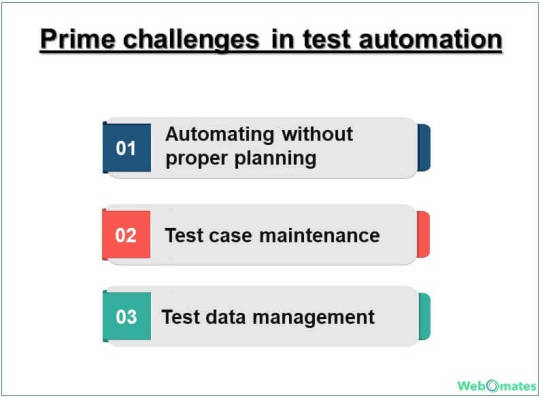
What is scalability in test automation?
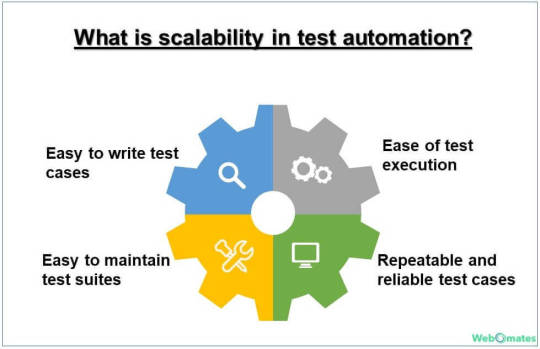
Easy to write test cases Manual test case writing can be a tedious task and after a while, it gets boring and error-prone. Test automation addresses this problem to a certain extent, but if that too needs manual intervention/checking, then the whole purpose of automation gets defeated. To achieve scalability, test automation should be able to generate test case scripts and update them periodically.
Ease of test execution The test execution process has to be simple, quick and should have a fast feedback loop. It encourages quick analysis and rectification of the issues, thus making the process scalable in case there is a major change or upgrade.
Easy to maintain test suites People dread changes, especially if they lead to an extra amount of work in changing test cases to keep them in sync with the latest versions. Test automation steps in here and takes off the load. Scalability quotient depends on how easily the test scripts get updated.
Repeatable and reliable test cases What is the point of having an automated test suite if it breaks every now and then? The test cases have to be reliable and can be executed multiple times making test results trustworthy.
Achieving scalable test automation
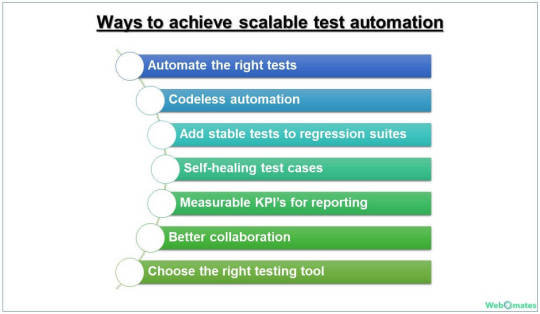
Automate the right tests Not every test can be automated. You have to identify the right tests to automate to ensure that test automation is scalable and you get the best value out of it. Here is a quick checklist to help you in making the decision. Automate the tests that
Are repetitive and span multiple builds
Require multiple input combinations
Verify and validate critical functionalities
Are executed in different test environments and require different hardware and software configurations
Are prone to errors if performed manually
Are reusable, maintainable, and resistant to changes
Codeless test automation Now that you have identified the tests that can be automated and render scalability, won’t it be great if scriptwriting is minimal or even better, not required? This is where codeless test automation steps in. Codeless testing spurs the whole testing process by quickly generating the test cases and effortlessly addressing any modifications during testing, thus increasing the reusability and maintainability quotient of the test cases. Defect rectification and re-testing becomes much easier with codeless testing. Test engineers can conduct multiple test runs without worrying about modifying long lines of code. If you wish to read in detail about codeless test automation, then do check our article “Top 5 benefits of codeless testing”.
Stabilize the tests before adding them to regression suites Let the tests stabilize before adding them to your test suite if you do not wish to spend precious resources on identifying what went wrong later. It is highly likely that the tests may fail because they were not stable and reliable.
Self-healing test cases The last thing that you would want is that your application crashes because you forgot to update the test case for the minor changes in requirement or bug rectification. Statistically speaking, approximately 20% of the test automation cost is in test script creation, and a major chunk, i.e. 80% is in test execution and test case maintenance. Clearly, it is a daunting task to keep test repositories up to date, if self-healing of test cases is not done. That is precisely why we need a test automation tool that can understand these changes and effortlessly self-heal the tests and re-execute them within the same cycle.
Measurable KPI’s for reporting purposes How do measurable KPIs render scalability? They ensure that you get the right value of test automation by presenting tangible values in the reports. They also help in understanding whether the right test cases have been automated, which takes us to our very first point of this discussion.
Better collaboration Better collaboration and enhanced communication aids in the quicker resolution of issues and improve transparency between the teams. This consequently leads to overall process improvement since all teams are on the same page of understanding and can work towards the common goal of how to get the best ROI from test automation.
Choose the right tool Choose the right testing tool which;
Is intuitive and easy to use
Is easy to integrate with an existing system
Supports multiple platforms
Enhances the values of test automation by leveraging the power of Intelligent test automation
Incorporates the principles of Shift left testing
Is feature-rich and gives best value for your investment
We have compared a few leading testing tools which are available in the market in our article “AI test automation tools to look out for in 2022”. For additional reading, you can also go through “How to choose the right automation testing tool”.
Webomates provides intelligent test automation solutions with intelligent analytics. It leverages the power of data processing, analysis, reasoning, and machine learning to provide an end-to-end testing solution for your business.
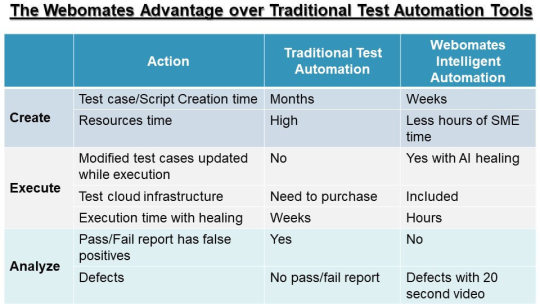
If you are looking for a one-stop solution for your testing needs then look no further, reach out to us at [email protected].
If you liked this blog, then please like/follow us Webomates or Aseem.
0 notes
Text
10 Latest Software Testing Tools QAs Are Using In 2023
Definition
Software Testing
Software testing compares software to user and system requirements. Testing can take place at either the phase or module level of the software development life cycle. Software testing includes validation and verification.
Software Testing Tools
Software testing tools ensure that software is still in development stage and meets project objectives. Software testing tools can also confirm a product’s dependability and security. The companies must be familiar with the tools that can help them with the quality assurance process.
Here are the ten latest software testing tools for quality assurance professionals in 2023.
Selenium: It is the most well-known and well-established software testing solution, with playback capabilities for functional test authors, test automation and frequent testing.
Nessus: Nessus is one of the best active scanners on the market. It offers fast discovery, asset profiling, fragile data discovery, and vulnerability analysis of security posture. It is used by many professional penetration testers and auditors.
Appium: It is one of the leading open-source mobile automation testing solutions, Appium has recently gained a lot of attention. The methodology behind Appium supports native, hybrid, and mobile apps and is based on the principle that testing native apps shouldn’t call for an SDK or recompilation. Testers adore Appium’s best feature, which lets them automate mobile apps with any testing framework or programming language.
Selendroid: Users recommend this software for Android apps; test writers can create test scripts using the software testing tool Selenium 2 client API, which can be used on both actual devices and emulators. Integrate Selendroid as a node with Selenium Grid to accelerate the testing process. The Advanced User Interactions API supports many motions, making it easier to create test cases.
Testsigma: It is the best option to centralize all aspects of your testing process, from design to reporting and debugging. This end-to-end automation tool for software testing solutions aims to make testing extremely simple and collaborative. It is successful in codeless automation testing. It can run on mobile, Web, and API tests using codeless test scripts and various capabilities.
Screenster: It is a useful tool for testing internet apps for regression. It works with any Windows operating system and requires Java 6 or higher and all major browsers. It enables verification and provides full API access as needed, taking screenshots at each stage and comparing them to the baseline.
SauceLabs: Application testing software allows users to run tests across 700 different OS, device, and browser combinations. It provides a complete test infrastructure for automated desktop and mobile application testing. This technology tests mobile apps and websites on both physical and virtual devices. It assists plugin integration with CI platforms and automated testing for continuous integration and delivery.
Squish: This is a powerful GUI automation solution for cross-platform desktop, mobile, embedded, and web applications. This program automates graphical user interface and HMI system and functional regression testing. It supports Webkit content and is cross-platform for AWT, SWT, RCP, Swing, and JavaFX apps.
JCrawler: An open-source web application stress (push) testing tool with crawling and exploratory highlights. In this case, the user can provide JCrawler with a large number of URLs to begin with, and the app will be loaded as it crawls each URL. The load parameters can be configured using an XML document, which can be started up as many times as needed to create the load constantly.
Cucumber: It is an open-source behaviorally driven development (BDD) tool. It has many notable clients to support several languages. It is only supported by the online environment, is used by 20% of testers, and was designed to provide a better end-user experience.
Conclusion
These software testing tools are the ones that quality assurance (QA) professionals should use in 2023. Additionally, individuals and organizations need to keep up with market developments. To stay ahead of the competition, test professionals, organizations, and teams should pay heed to these market trends.
0 notes